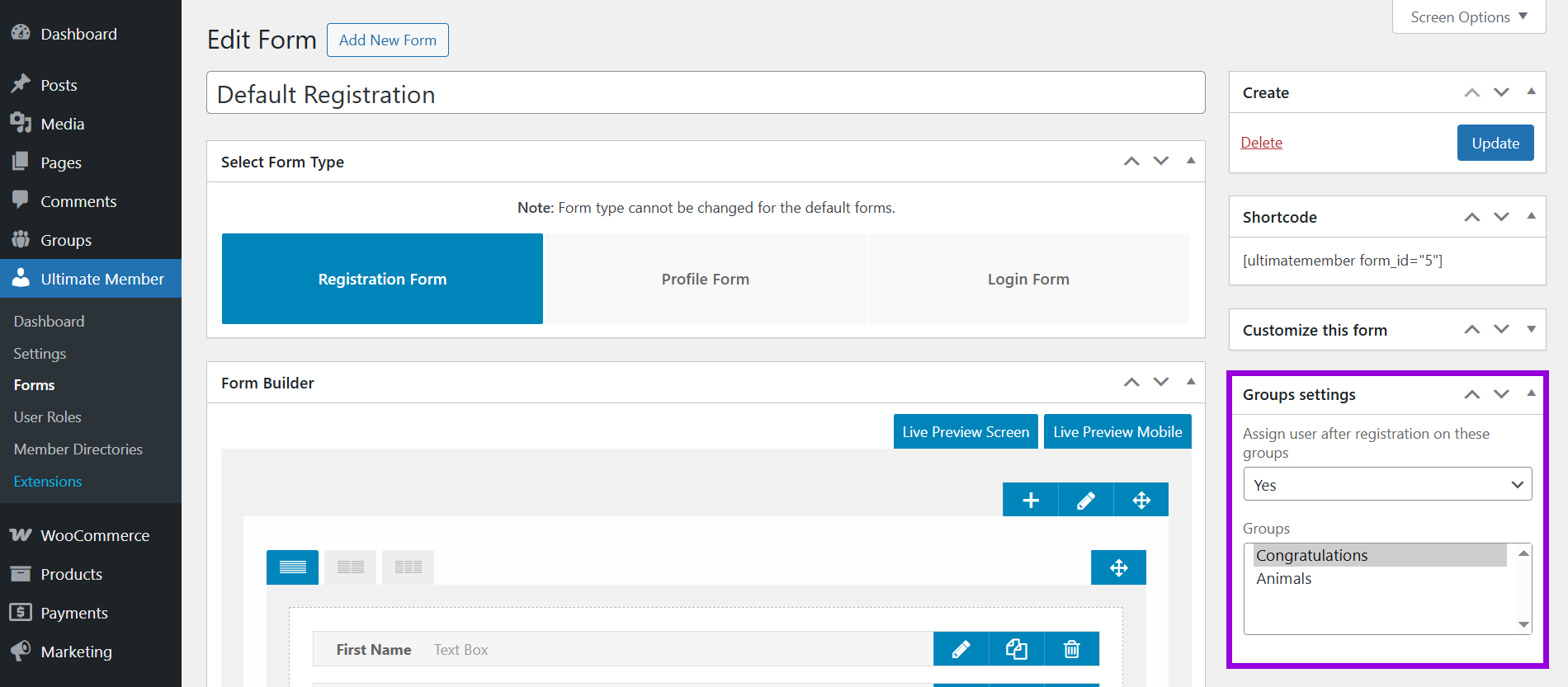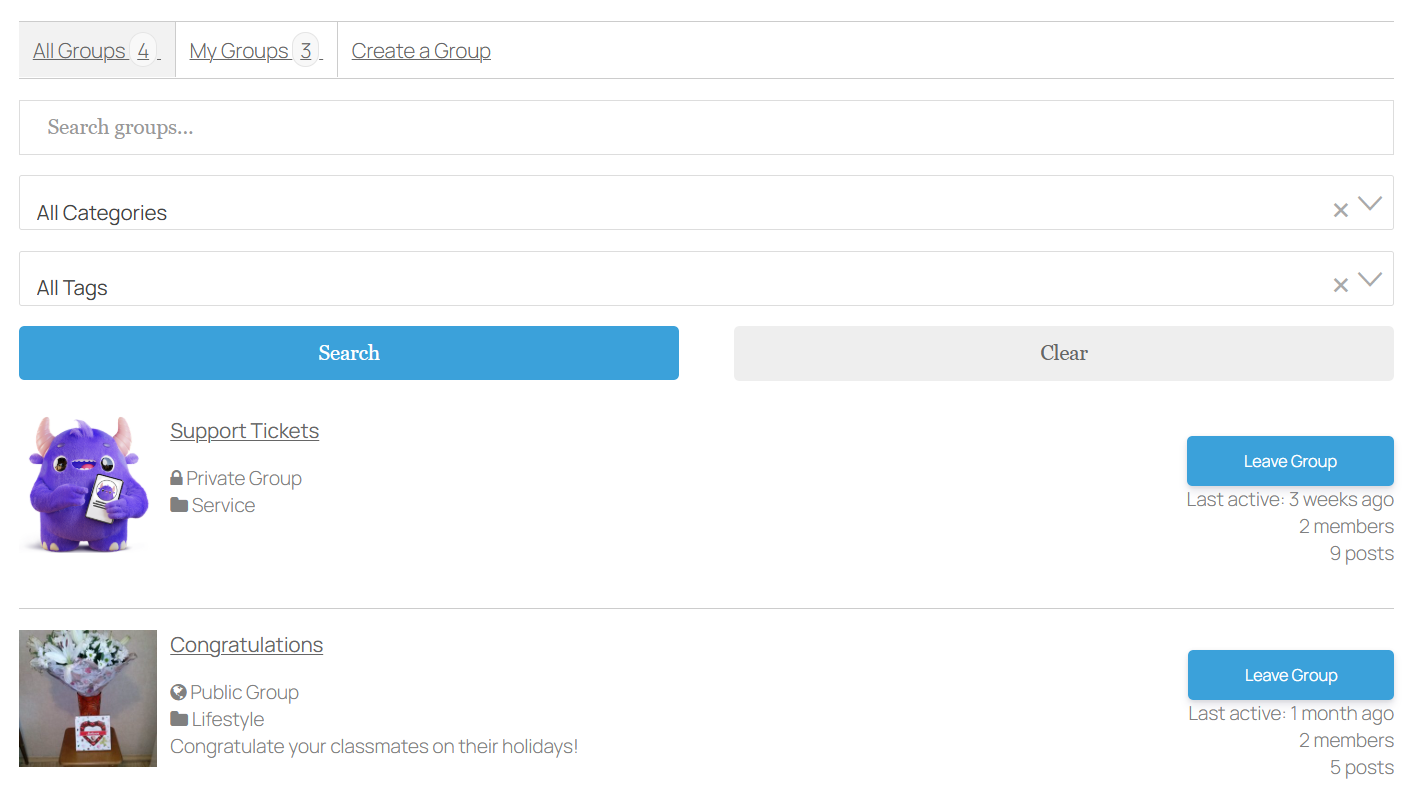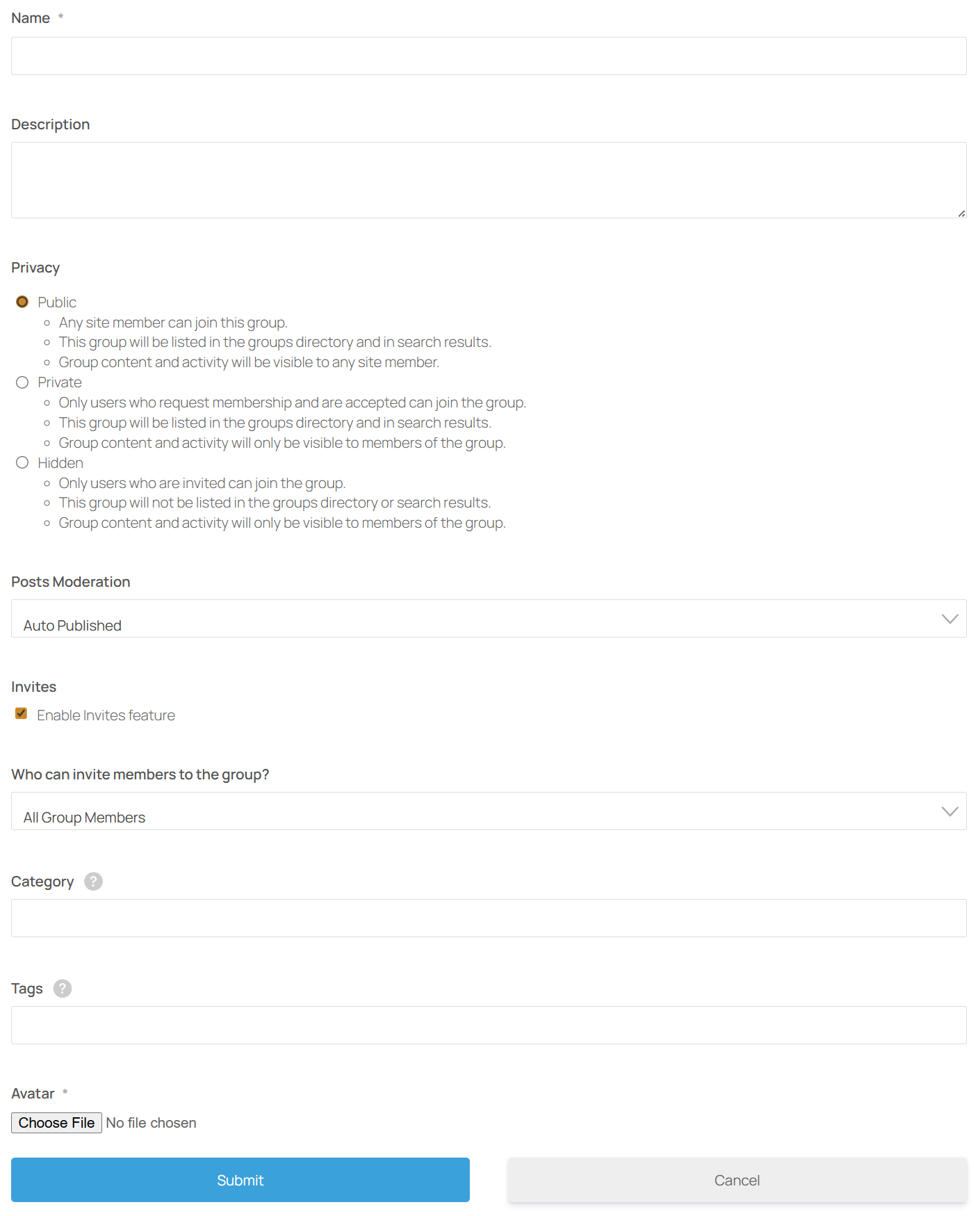Groups setup
Overview
Groups extension allows users to create and join groups around shared topics, interests, etc., and increase user interaction on your site. This document provides instructions on how to setup Groups extension.
Contents
- Settings
- Registration form settings
- User Role settings
- Manage groups
- Frontend features
- Notifications
Settings #
Extensions settings #
Once you activate the extension, you will see the Groups tab on the page wp-admin > Ultimate Member > Settings > Extensions. On this page, you can find the following options:
- Edit Groups slug, Category slug & Tag
- Turn on/off group avatars "Show group avatars"
- Setup the number of displayed posts for the mobile/desktop view
- Setup comments order
- Setup number of initial comments/replies to display per post

Profile Menu settings #
The extension adds settings to the page wp-admin > Ultimate Member > Settings > Appearance > Profile Menu. These settings allow you to manage the "Groups" item in the profile menu:
- Groups Tab – Allows enabling/disabling the "Groups" item in the Profile menu.
- Who can see Groups Tab? – Manage access to the "Groups" tab in the Profile menu

Pages settings #
The extension adds settings to the wp-admin > Ultimate Member > Settings > General > Pages screen. These settings allow you to manage required pages:
- Create Group - Displays a form to create a group.
- My Groups - Displays current user groups.
- Groups - Displays all public and private groups.
- Invites - Displays the invite members block.

The extension creates pages automatically. You can use page settings to recreate pages manually if they were lost. Once pages are created, you can manage them on wp-admin > Pages > All Pages.
Page Groups contains the [ultimatemember_groups] shortcode that shows a list of groups. Members can search a group, see a group info, join a group.
Page Invites contains the [ultimatemember_group_users_invite_list] shortcode that allows members to invite other members to the group.
Registration form settings #
The extension adds the Groups settings section to the registration form settings. This allows you to set up automatic additions of new users to a specific group. Please note that this feature only works with public groups.

User Role settings #
The extension adds the Groups section to the user role settings. Go to wp-admin > Ultimate Member > User Roles, choose the user role and scroll down to see this section. You'll see these settings:
- Turn off creation group? - turn on this setting to deny creating groups for this role.

Manage groups #
The extension adds the Groups section to the WordPress admin menu where you can view existing groups, add a new group or edit group settings.
You can view and manage group categories on wp-admin > Groups > Group Categories.
You can view and manage group tags on wp-admin > Groups > Group Tags.

Add a new group #
Click the Add New Group button above the Groups table to add a new group. Configure a group settings and click the Add Group button.
A group settings #
Group settings are divided into 4 main widgets: Settings, Invites settings, Add New Members, Manage Members.

Settings section #
- Privacy - set privacy settings for your group. Options:
- Public - Any site member can join this group. Group content and discussions are visible to any site member.
- Public for Role - Members with specific role(s) can join this group. Group content and discussions are visible to members with specific role(s).
- Private - Only members who request membership and are accepted can join the group. Group content and discussions are visible to members of the group.
- Hidden - Only members who are invited can join the group. Group content and discussions are visible to members of the group. This group is not listed in the groups' directory or search results.
- Role list - (optional, appears if "Public for Role" is chosen in the Privacy) limit access by user role.
- Post Moderation - enable/disable post moderation by admins or group moderators.

Invites settings section #
- Enable Invites feature - enable/disable invites for the group.
- Who can invite members to the group? - select who can invite new group members. Options.
- All Group Members
- Group Administrators & Moderators only
- Group Administrators only
- Enable Invites search - enable/disable searching tool.
- Enable Invites filters - enable/disable filtering tool.
- Choose field(s) to enable in search - select fields for filtering if "Enable Invites filters" is enabled.

How it looks like on the group page:

Add New Members section #
You can add new members to the group by searching for registered users and clicking on the "Add member" button.
Step 1 - Search a member

Step 2 - Add a member

Manage Members section #
Manage members section allows you to manage group members:
- Change member status - Hover over the status of the member to select the following status from the drop-down menu: Pending Admin Review, Pending Member Review, Approved, Rejected, and Blocked
- Assign/change member role - Hover over the group role of the member to select the following group role from the drop-down menu: Administrator, Moderator, Member and Banned.
- Send invite or expel members from the group

Frontend Features #
Groups page #
Groups page displays a list of groups.
At the top of the page the All Groups, My Groups, Create a Group links are shown. The My Groups link filters a list of groups to display groups the current member has joined. The Create a Group link navigates to the "Create Group" page.
Below the links a search bar and filters are shown. These elements are used to search and filter the list of groups displayed below.

Single group page #
On the single group page these sections are available:
- Discussions tab represents the main group discussion feed.
- Members tab displays all group members.
- Send Invites tab can be used to send invites to other members.

Admin users or group moderators can access group settings on the frontend by clicking the "gear" icon on the upper right side of the group page. All group settings can be changed on the frontend by group admins or moderators.

Create Groups page #
This page displays a form to create a group. The person who created the group is the first group member and the group administrator.

Notifications #
The extension supports email notifications and real-time notifications.
Email notifications #
The extension adds these email templates:
- Groups - Approve Member - Send the user an email when the user is approved to a group
- Groups - Join Request - Send the user an email when the user has requested to join their group
- Groups - Invite Member - Send the user an email when the user has been invited to join a group
- Groups - New post - Send the user an email when someone posts on the group wall
- Groups - New comment - Send the user an email when someone comments on the group wall
Email templates support common email placeholders and some specific:
- Groups - Approve Member template supports: {group_name}, {group_url}.
- Groups - Join Request template supports: {moderator_name}, {member_name}, {group_name}, {group_url}, {groups_request_tab_url}, {profile_link}.
- Groups - Invite Member template supports: {group_name}, {group_url}, {group_invitation_guest_name}, {group_invitation_host_name}.
- Groups - New post template supports: {group_name}, {group_url}, {group_url_postid}, {post_url}, {author_name}, {author_photo}, {member_name}, {content}.
- Groups - New comment template supports: {group_name}, {group_url}, {group_url_postid}, {group_url_commentid}, {post_url}, {comment_url}, {author_name}, {author_photo}, {member_name}, {content}, {comment}.
Administrators can edit email templates: enable, disable, change subject or body. Go to wp-admin > Ultimate Member > Settings > Emails, find the needed email template, and click the "Manage" button. You'll see email template settings. Change what you want and save changes.

Members can enable or disable email notifications Groups - New post and Groups - New comment using settings on the page Account > Notifications. These settings are disabled by default.

Real-time notifications #
Note: Real-time notifications require the extension Ultimate Member - Real-time Notifications.
Real-time templates:
- Groups - Approve Member - When my group requests have been approved
- Groups - Join Request - When a user requested to join their group
- Groups - Invite Member - When a member has been invited to join a group
- Groups - Change Group Role - When my group roles have been changed
Example of the Invite Member real-time notification:

Members can enable or disable real-time notifications using settings on the page Account > Web notifications.
